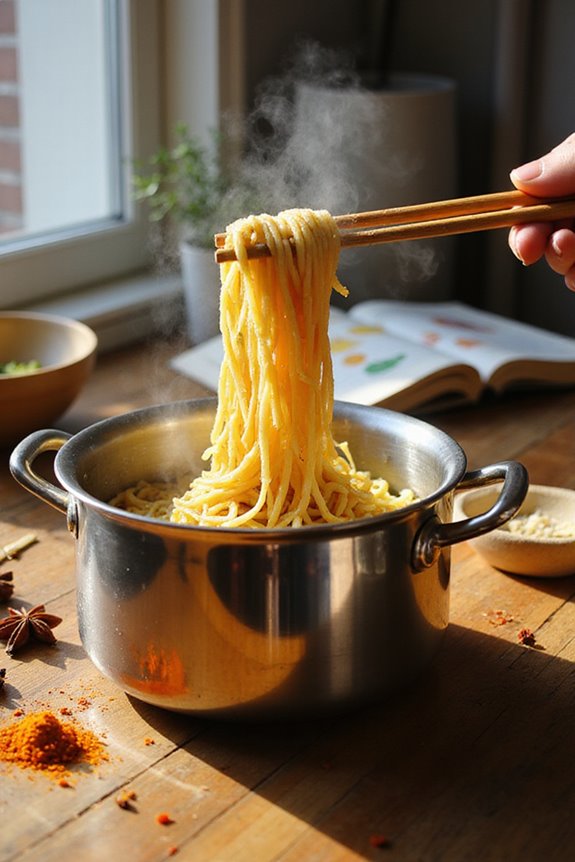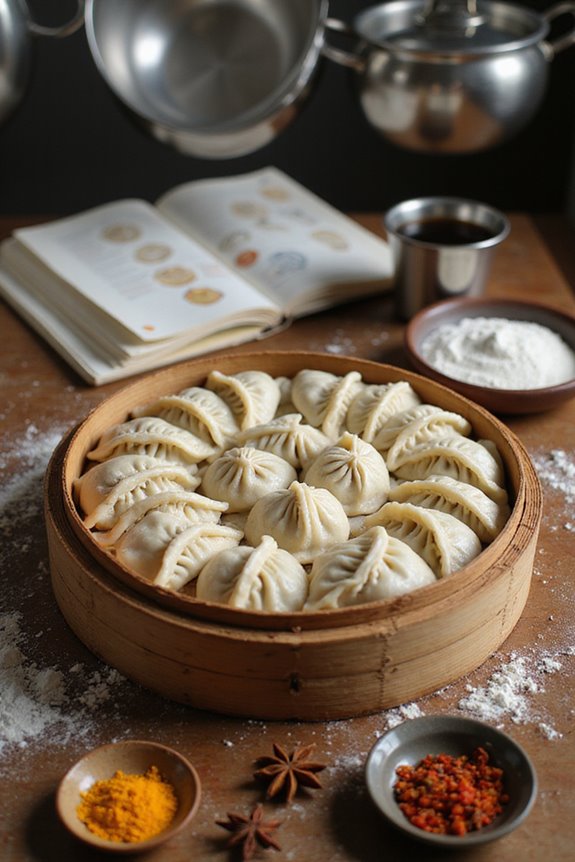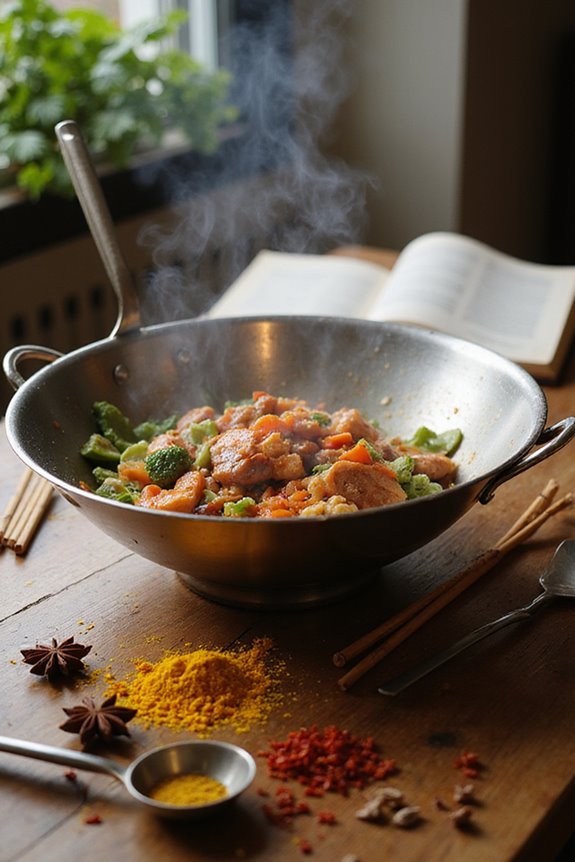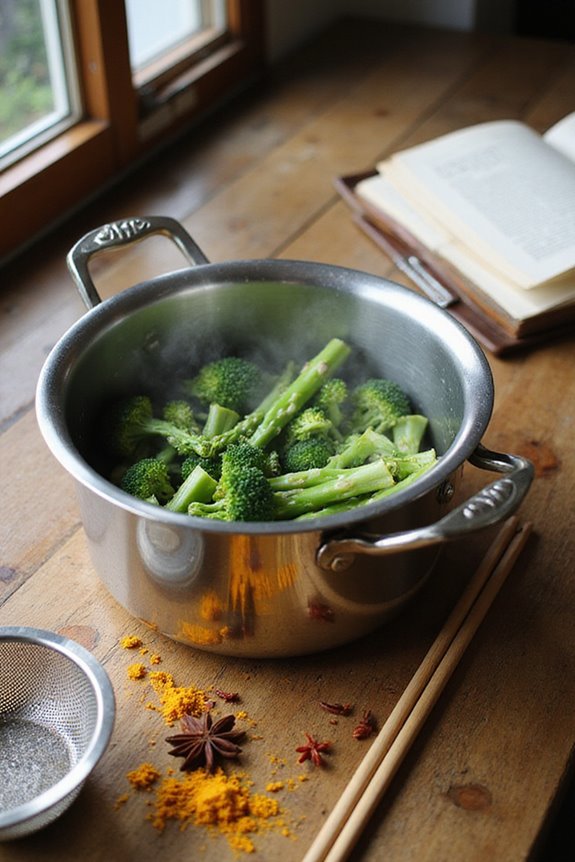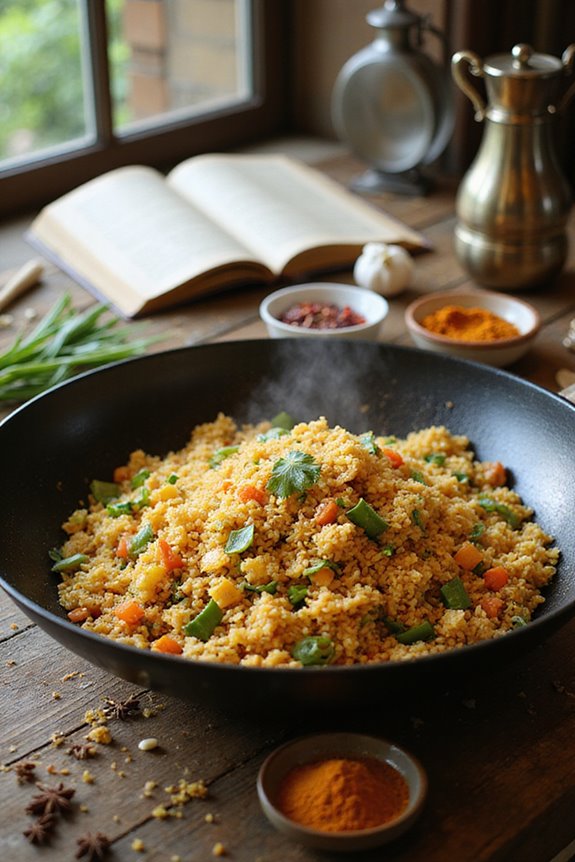To cook noodles al dente, let’s make this a delightful experience! Begin by boiling 5-7 quarts of water, then toss in 1-2 tablespoons of salt – think of it as seasoning joy! Add your pasta and stir for the first two minutes to avoid clumping. Cook 2-3 minutes less than the package suggests, and test for that perfect firm bite. Drain while it’s still slightly chewy, and you’ve got a magical dish ready for your favorite sauce! Stick around to learn even more pasta secrets!
Key Takeaways
- Use 5-7 quarts of boiling salted water for every pound of noodles to enhance flavor and prevent sticking.
- Cook noodles 2-3 minutes less than package instructions for optimal al dente texture.
- Stir noodles for the first couple of minutes to prevent clumping and ensure even cooking.
- Taste the noodles a minute or two before the suggested cooking time ends to check for firmness.
- Drain and toss noodles with sauce immediately to retain texture and absorb flavors better.
Understanding Al Dente: What It Means
When it comes to pasta, nothing beats the delightful sensation of al dente! This Italian phrase means “to the tooth,” and it perfectly describes that ideal pasta texture we all love. Achieving al dente involves using the right cooking methods, where pasta is firm yet tender, just like the best surprises during the holiday season!
- The magic happens when we cook pasta just 2 to 3 minutes less than the package instructions.
- We can test its readiness by biting and checking for a slight resistance.
- If we’re feeling adventurous, remember “molto al dente” is even less cooked!
- For a quick meal, you might want to consider using GENKI-DO! Plant-Based Japanese Ramen since it cooks in just 1 minute!
Let’s embrace the al dente journey together and make every pasta dish a delicious celebration!
Importance of Cooking Pasta Al Dente
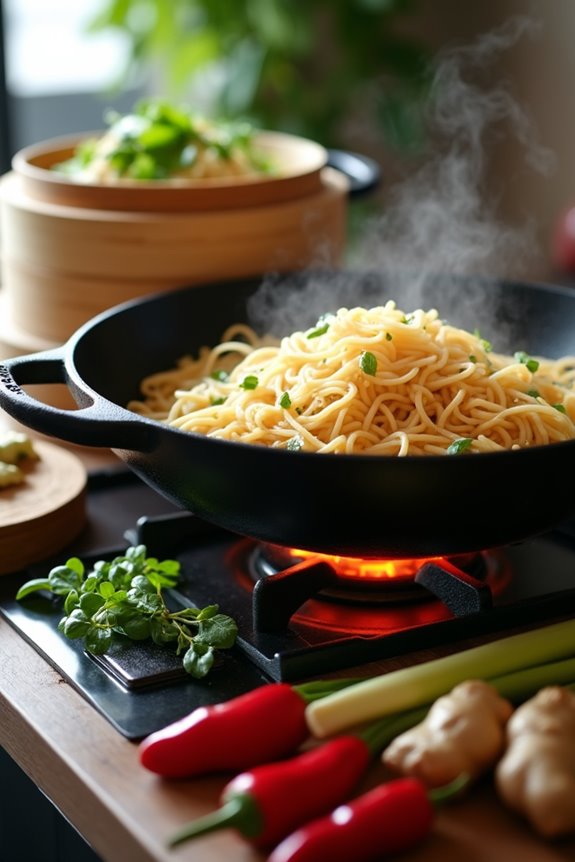
Cooking pasta al dente isn’t just about the texture—it’s about a world of benefits that makes our meals not only tastier but healthier! Here’s why we should embrace this delightful cooking technique:
- Health Benefits: Al dente pasta has a lower glycemic index, keeping our blood sugar stable.
- Better Digestion: The firmer texture promotes chewing and helps our digestive enzymes work their magic!
- Nutritional Preservation: This method preserves vitamins and minerals, ensuring our meals are nutrient-dense. Additionally, cooking methods that retain nutrients, like al dente pasta cooking, align with the principles of Asian cuisine to maximize flavor and nutrition.
Types of Pasta and Their Cooking Times
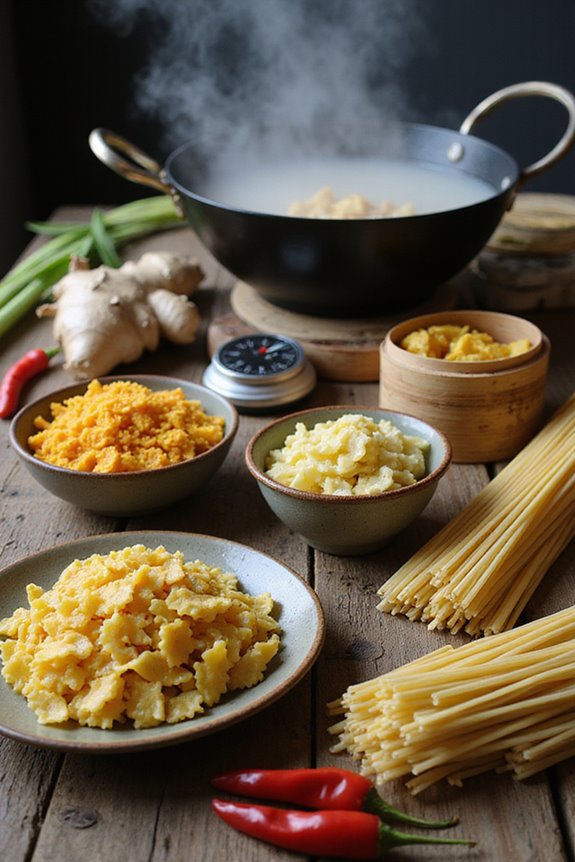
So, let’s plunge into the delightful world of pasta! The magic of pasta varieties is how each brings its own cooking methods and times to our dishes. Here’s a quick rundown to keep us on track:
- Spaghetti: 8–10 minutes for that perfect bite.
- Penne: Closer to 10 minutes usually does the trick.
- Farfalle: Those cute bow-ties need about 13–15 minutes.
- Fresh Pasta: Capellini cooks in just 1–2 minutes!
Don’t forget about specialty noodles like soba, which take 6–7 minutes. Remember, overcooking can ruin the fun! With high-quality materials contributing to heat distribution efficiency, we can easily whip up our favorite meals, making every dish a celebration. Happy cooking, pasta enthusiasts!
Factors Affecting Cooking Time
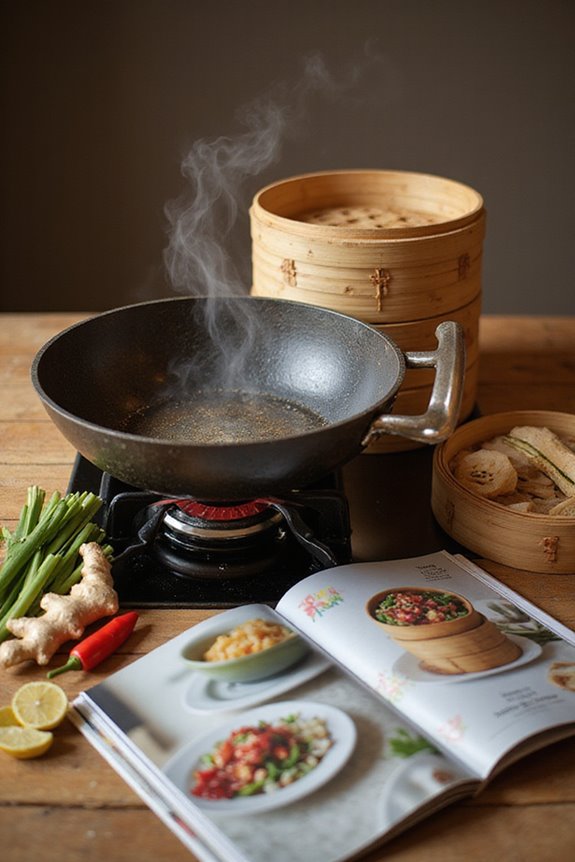
We’ve explored the different types of pasta and their cooking times, but cooking pasta al dente is an adventure influenced by a number of factors.
Key Factors to Reflect On:
- Water Temperature: Hot water (around 80-85 °C) lets starches swell properly.
- Salt Concentration: Salt is your pasta’s best friend! It boosts flavor and texture, helping it hold its shape.
- Pot Size: A big pot is a must! It keeps our pasta from feeling cramped and helps it cook evenly.
- Pasta Freshness: Fresh pasta cooks quicker, while dry pasta takes its time.
- Starch Composition: Different types of starch play a magical role in the final texture. Additionally, using high-quality tools can enhance your cooking experience by improving efficiency and precision.
Cooking Techniques for Perfect Al Dente Pasta
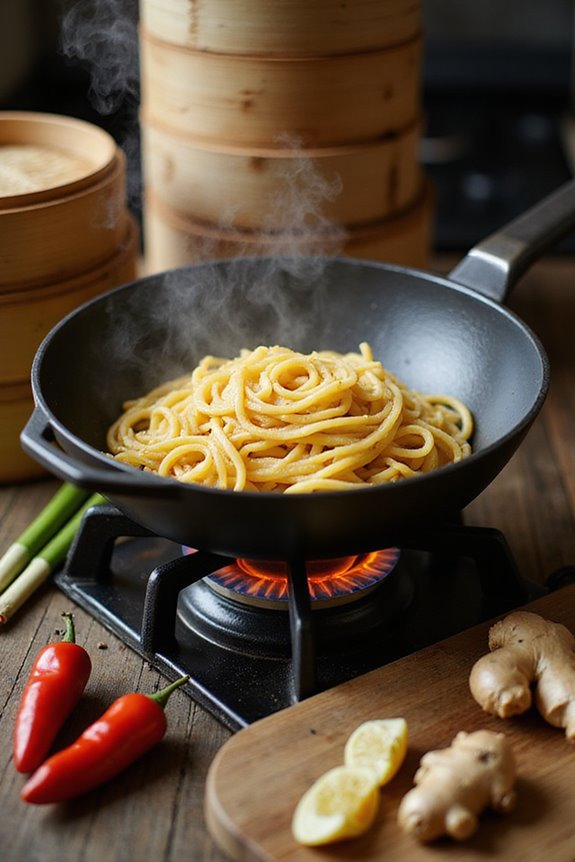
Achieving perfectly al dente pasta is like finding the secret ingredient in a magical recipe—it’s where delightful texture meets fantastic flavor! To start, we need plenty of water—5-7 quarts per pound of pasta—to keep things moving. Let’s add salt once it’s boiling, about 1-2 tablespoons, but hold off on the oil unless we’re using filled pasta shapes like ravioli. When we toss the pasta in, stirring for those first 1-2 minutes helps prevent sticking.
Now comes the fun part: cooking time! We should cook it 2-3 minutes less than the package suggests, and test a piece for that perfect bite. Using different lengths of utensils ensures efficient stirring and mixing, enhancing our pasta’s texture and flavor. Tossing it with our sauce at the end means flavor magic! Let’s savor our creation, friends!
Tools and Equipment for Cooking Pasta
When it comes to cooking pasta, having the right tools is like having a trusty sidekick in a superhero movie—absolutely essential! For delightful pasta cooking, we’ll need:
- Stockpot: A big pot guarantees we can boil noodles evenly in plenty of water.
- Colander: This handy tool helps us drain the pasta quickly so it doesn’t overcook.
- Spider Strainer: Perfect for lifting noodles without losing all that boiling water!
And let’s not forget our mixing bowls for dough prep and pasta tongs for serving. A stainless steel spider strainer can also enhance our ability to cook noodles with precision. Without these kitchen tools, we might feel like superheroes without our capes! So, gather your gear, and let’s make cooking pasta a magical experience together!
Tips for Testing Pasta Texture
How can we tell if our pasta is perfectly cooked to that delightful al dente texture? Let’s embrace some simple tips for tactile testing and texture assessment!
- Bite Test: Gently bite into a noodle; it should yield some resistance but not crunch.
- Visual Cues: Notice the increase in girth; it should look plump but not mushy.
- Stickiness Check: Al dente pasta sticks together a bit; if they cling too much, they might be overcooked!
Don’t forget to regularly taste during the last few minutes of cooking. This magical combination of senses will help us achieve that satisfying al dente mouthfeel we all crave. Happy cooking, and may your pasta be perfectly delightful!
Common Mistakes to Avoid
After we’ve tested our pasta for that delightful al dente texture, it’s time to switch gears and focus on common mistakes that can trip us up. Here are some pitfalls to dodge:
- Pot Size: Use at least 6 liters of water per 500 grams of pasta; a cozy pot can lead to chaos and clumping.
- Salting Water: Don’t skip the salt! 1-2 tablespoons in boiling water gives our noodles that magical flavor.
- Oil Addition: Adding oil is a slippery slope! It keeps sauces from sticking—let’s stick to stirring instead.
- Rinsing Pasta: Hold the rinse unless it’s for a fancy salad! We want all that lovely starch to cling to our delicious sauce.
- Cooking Time: Test those noodles early! Aim for that perfect bite, not mushy mayhem.
Pairing Al Dente Pasta With Sauces
Pairing al dente pasta with the right sauce can transform our cooking experience into a delightful culinary adventure! Let’s explore some magical combinations based on sauce compatibility and pasta shapes.
- Long Pastas: Think spaghetti or fettuccine with light sauces like pesto or carbonara.
- Short Pastas: Use rigatoni or penne for heartier sauces like Bolognese, which cling beautifully.
- Tiny Pastas: Save pastine for brothy soups—rich sauces might just overwhelm them!
- Stuffed Pastas: Ravioli and tortellini shine with lighter sauces to let their fillings sparkle.
Enhancing Flavor and Texture With Al Dente Cooking
When we cook pasta to that perfect al dente stage, it’s like revealing a magical treasure of flavor and texture! This delightful firmness enhances flavor enhancement as sauces cling better to each noodle, ensuring every bite bursts with taste. The delightful texture contrast, providing a slight chew, slows down our eating, helping us savor our meals and feel full longer.
To keep it festive, think of al dente pasta as a holiday treat for your taste buds! Embrace that bit of resistance; it’s not just pasta, it’s an experience. Plus, maintaining more nutrients keeps us energized and satisfied. So, let’s keep our noodles firm, flavorful, and fabulous, ensuring every meal is a merry occasion!
Frequently Asked Questions
What Types of Sauces Work Best With Al Dente Pasta?
When we think about pasta sauces, creamy, tomato-based, and pesto options all shine with al dente textures. The best sauce pairings balance flavor and bite, making every bite enjoyable and satisfying together.
Can I Use Gluten-Free Pasta for Al Dente Cooking?
Absolutely, we can use gluten-free options for al dente cooking! Just remember, cooking times are essential—those delightful textures can vanish in seconds if we’re not vigilant. Let’s master this together!
How Can I Store Leftover Al Dente Pasta?
When we store leftover al dente pasta, we should guarantee proper storage in airtight containers. For reheating, let’s add a splash of water or sauce, so it stays delicious and doesn’t dry out.
Is There a Recommended Salt Amount for Boiling Pasta?
When it comes to boiling pasta, we should aim for about 1 to 2 tablespoons of salt per 4 quarts of water. This salt measurement enhances flavor, making our pasta taste deliciously satisfying together.
Can I Reheat Al Dente Pasta Without Losing Its Texture?
Yes, we can reheat al dente pasta without losing its texture with proper reheating techniques. By adding moisture and using gentle heat, we can guarantee better texture preservation and enjoy delicious leftovers together!

